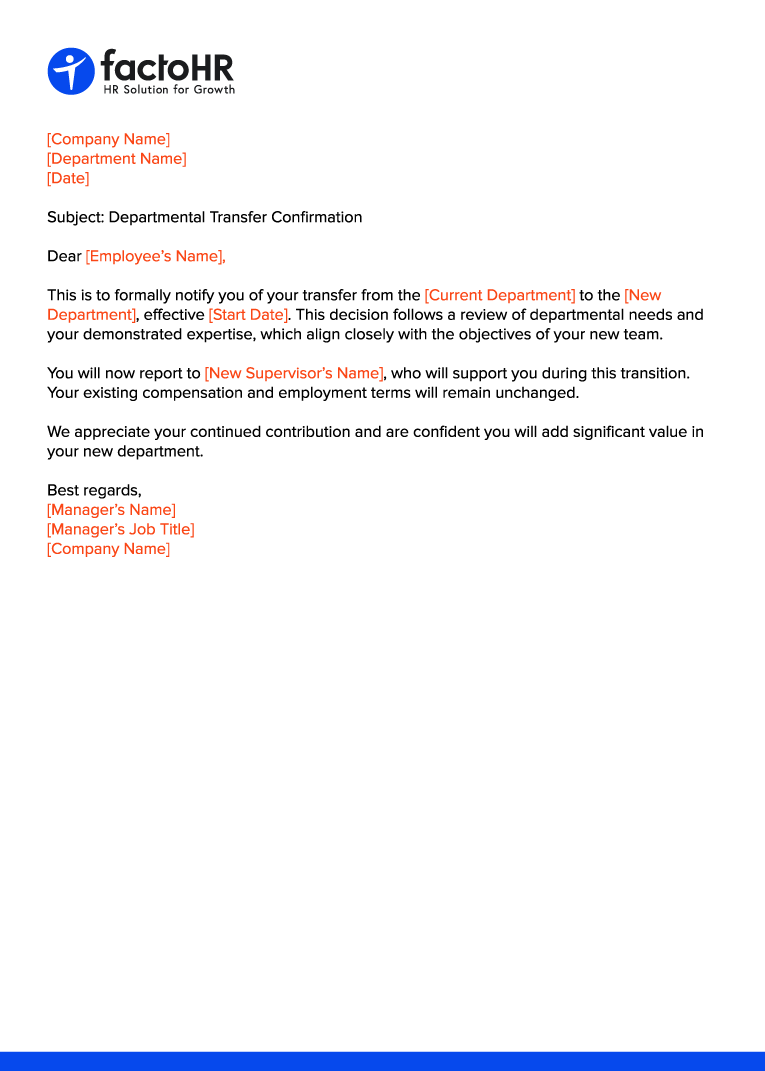Employee Transfer Letter Format [+5 Free Samples]

Download Simple Employee Transfer Letter for Free
Table of Contents
As an HR professional, writing employee transfer letters manually can be tedious. You need to spend time and resources, and ensure that the letter conveys all the details properly. However, with a transfer letter template you can reduce the time and effort required. Our employee transfer letter templates can help you craft communications with employees informing them of the transfer in a professional manner.
We have added a downloadable format that you can directly edit and send to the employee in a few seconds. Whether you are looking to inform employees about promotion, transfer to a different department, or role adjustment, our templates cover it all. So without wasting much time, let’s first understand what a transfer letter is and how to write it effectively with our templates.
Key Takeaways
- Ready-to-Use Templates
- Standard Format
- Transfer vs. Request
- Writing Tips
- HR Accuracy
- Time-Saving Tools

What is a Transfer Letter and when is It Used?
A transfer letter is a document issued by a company that notifies an employee of a transfer to another department or office. It also describes new duties and expectations, which help minimize confusion during transitions.
It confirms that the employee possesses the requisite skills for the new post and can justify requests for title or salary increases.
The HR department or the manager usually writes the transfer letter after the company authorizes the transfer. Employees who wish to be transferred to a new position are expected to submit a transfer request letter to the company.
Employee Transfer Letter Format

A well-drafted employee transfer letter ensures transparency, defines the employee’s new responsibilities, and maintains compliance with company policies. Below are various types of employer-issued transfer letters with ready-to-use templates.

Departmental and Role-Based Transfer Letters
A departmental transfer letter is issued when an employee is reassigned to a different department based on business needs, skill alignment, or resource optimization. It specifies the new department, reporting manager, and effective date.
A role-based transfer letter is used when the employee’s position or job title changes while remaining within the same level of hierarchy. It formally documents the revised title and responsibilities for internal records.
[Company Name]
[Department Name]
[Date]
Subject: Departmental Transfer Confirmation
Dear [Employee’s Name],
This is to formally notify you of your transfer from the [Current Department] to the [New Department], effective [Start Date]. This decision follows a review of departmental needs and your demonstrated expertise, which align closely with the objectives of your new team.
You will now report to [New Supervisor’s Name], who will support you during this transition. Your existing compensation and employment terms will remain unchanged.
We appreciate your continued contribution and are confident you will add significant value in your new department.
Best regards,
[Manager’s Name]
[Manager’s Job Title]
[Company Name]
Relocation and Internal Company Transfer Letters
A relocation transfer letter is issued when an employee is reassigned to another branch, office, or geographical location to meet operational or strategic needs. It outlines details of the new workplace, reporting structure, and employment continuity.
[Company Name]
[Department Name]
[Date]
Subject: Notification of Role Transfer
Dear [Employee’s Name],
We are pleased to inform you of your transfer to [New Location/Branch] as part of our organizational realignment initiative, effective [Start Date]. You will take on the role of [New Job Title], reporting to [Supervisor’s Name].
Your compensation and benefits will continue as per company policy. The HR department will coordinate with you to facilitate a smooth transition and relocation process.
We look forward to your continued commitment and contribution to [Company Name] in your new role.
Sincerely,
[Manager’s Name]
[Manager’s Job Title]
[Company Name]

Temporary and Permanent Transfer Letters
A temporary transfer is issued when an employee is assigned to a project, task force, or another department for a fixed duration, while a permanent transfer indicates a long-term role change. Both require clear documentation of terms, start dates, and reporting relationships.
[Company Name]
[Department Name]
[Date]
Subject: Temporary Transfer Notification
Dear [Employee’s Name],
This letter confirms your temporary transfer to the [New Office/Department] effective [Start Date]. This move supports ongoing project requirements as part of our operational restructuring.
Your new reporting manager will be [Supervisor’s Name]. The transfer will remain in effect until [End Date], after which you will resume your original role unless otherwise notified.
All employment terms and benefits will continue as per your existing agreement. For any logistical assistance, please contact the HR department.
We appreciate your cooperation and professionalism during this transition.
Best regards,
[Manager’s Name]
[Manager’s Job Title]
[Company Name]
Promotion Transfer Letter
A promotion transfer letter is issued when an employee is promoted to a higher role that may involve a departmental or locational change. It serves as both a promotion announcement and a formal notice of transfer.
[Company Name]
[Department Name]
[Date]
Subject: Promotion and Departmental Transfer
Dear [Employee’s Name],
We are pleased to announce your promotion to the position of [New Job Title], effective [Start Date]. Along with this promotion, you will be transferred to [New Department/Location] to undertake your new responsibilities.
This decision reflects your consistent performance, leadership potential, and valuable contributions to the company. Your new supervisor, [Supervisor’s Name], will assist you during this transition. Updated details regarding your compensation and benefits will be shared by HR.
We congratulate you on this achievement and look forward to your continued success in this role.
Sincerely,
[Manager’s Name]
[Manager’s Job Title]
[Company Name]

Employee-Initiated Transfer Request
Although initiated by employees, such requests are reviewed and approved based on organizational feasibility and HR policies. Below is the standard format employers can share with employees.
[Employee’s Name]
[Employee’s Job Title]
[Current Department]
[Date]
Subject: Request for Internal Transfer
Dear [Manager’s Name],
I would like to formally request a transfer to the [Preferred Department/Location], effective [Preferred Start Date], due to [brief reason].
During my tenure in [Current Department], I have contributed to several key initiatives including [Example]. This transfer would allow me to continue contributing to company goals while aligning with my personal and professional development.
Thank you for considering my request. I am open to discussing this further at your convenience.
Sincerely,
[Employee’s Name]
[Contact Information]
Essential Elements of an Effective Transfer Letter
The transfer letter must be well structured and should present all the important information in an easy format. Make the letter brief and eliminate any redundant information.
The following are the necessary contents to include in your transfer letter:
- Employee Information: Provide the full name of the employee and his/her current job title and a concise description of the job.
- Transfer Details: State the name of the new department and the most recent job title. On this note, also any new location, as necessary.
- Effective Date: Indicate the actual date of commencement of the new position.
- Reason of Transfer: State the reason why one is transferred, like a change in department, a change of job status, or a relocation.
- Reporting Structure: This will indicate who the new manager or supervisor is to the employee.
- Contact Information: Include the HR or supervisor’s contact information for workers to address their questions related to the change.
A properly developed transfer letter is a formal document that the HR department and the employee can count on.

Common Mistakes to Avoid in Company Transfer Letters
When writing a transfer letter, it’s important to choose your words carefully. Make sure your letter is free of errors. If you don’t use polite and appropriate language, your message may not be understood, which can make you appear unprofessional. Paying a little attention to your writing can help you avoid these issues.This would render you less professional. A little attention to your writing would put you out of all these troubles.
The common mistakes that one should be cautious about are:
- Imprecise or Incomplete Information: If you fail to include details such as the date of commencement, the new job, or the manager’s name, the employee might be left confused. They will not be aware of the change and what it entails for them.
- Wrong Recipient: If you send the letter to the wrong recipients, it will not reach its intended recipients. This would create issues for both parties.
- No Justification: When you fail to state the reasons for the move, workers will feel confused. They will be interested in knowing why and what it entails for their work.
- Informal Tone: A letter with an informal sound will not be so formal. Individuals might not consider it a serious or real notice of a new position or the date of commencement, since their manager’s name is shared.
What is the Difference between Transfer Letter and Transfer Request Letter
A transfer letter and a transfer request letter serve distinct purposes. A transfer letter is issued by a company to inform an employee about their relocation. In contrast, a transfer request letter is written by an employee seeking a transfer to a different location or a change in their job description within the company.
A request letter is a formal letter requesting something from the company, and a transfer letter is a message from the management. The name of the company and letterhead, will be present in both letters, though for different persons and different reasons.
The following is a basic description of their characteristics:
| Feature | Transfer Letter | Transfer Request Letter |
|---|---|---|
| Initiator | Employer or HR Department | Employee |
| Purpose | To inform the employee of a decided transfer | To ask for consideration for a transfer |
| Tone | Informative and official | Persuasive and professional |

FAQ
Would I Mention the Reasons for Transfer in My Transfer Letter?
When preparing a transfer request, one should have an apparent reason. You may want to take on new challenges or have personal reasons. Such a brief description helps others understand why you are asking and makes your request more solid.
What is the Format of a Transfer Mail when It is an In-House Move?
In composing a letter to the HR manager to transfer, begin with a subject. State your present position and the job you want. State in brief the reasons why you changed and conclude with a professional touch. Write formally and be to the point.
Are Transfer Letter Templates Customizable to Various Employment Jobs?
With transfer letter templates, you have an opportunity to emphasize the applicable skills in a new job and narrate what you are doing. This will make your letter concise, since you are applying to a job and this will help to keep your writing to the point.
Can an Employee Refuse a Transfer?
Yes, an employee can refuse a transfer, but the decision depends on company policies, employment agreements, and the reason for the transfer.
When Should I Issue an Employee Transfer Letter?
An employee transfer letter should be issued after the transfer decision is officially approved by management or HR. It serves as a formal communication outlining the employee’s new department, role, reporting manager, and effective date of transfer.
Explore All HR Letter Templates for Every Need

Modernize your HR tasks with factoHR today
Experience the digitalization of everyday business activities with factoHR's modern and compatible solutions for every need.

© 2025 Copyright factoHR


